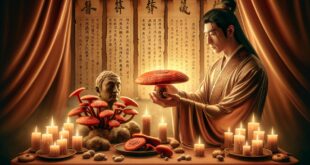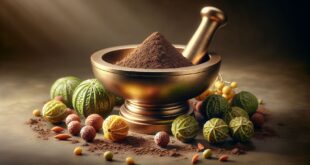If you ever think modern medicine has all the answers, take a step back—way back—to ancient Egypt. These people weren’t just building pyramids and mummifying their dead; they were seriously ahead of the game when it came to healing herbs and plant-based treatments. Their approach to holistic health wasn’t just superstition wrapped in papyrus scrolls—it was grounded in real, observable effects. Some of their remedies hold up so well that even today, we still turn to them, albeit in fancier bottles and capsules.
The Power of Garlic and Honey—Nature’s Dynamic Duo
Let’s talk garlic. You know it for jazzing up pasta sauce, but in ancient Egypt, it was practically a superfood. Healers prescribed it for infections, digestive issues, and even stamina (workers building the pyramids chewed on it to keep going). Modern science backs this up—garlic contains allicin, a compound with antibacterial and antiviral properties. It’s so effective that even now, some people swear by raw garlic when they feel a cold coming on. Sure, it might destroy your breath, but it might also save you a trip to the doctor.
And honey? Oh, the Egyptians adored it. This wasn’t just some sweet treat; it was a medical staple. The antiseptic properties of honey meant they used it to dress wounds and prevent infections—a practice modern medicine hasn’t abandoned. Even hospitals today still use medical-grade honey for wound care, which just proves how well these ancient medicine techniques actually worked.
Aloe Vera—The Timeless Soother
You’ve slathered it on a sunburn, right? Well, the Egyptians figured that out long before your local drugstore bottled it. Aloe vera was a go-to remedy for burns, cuts, and other skin ailments. Cleopatra—yes, that Cleopatra—was said to use it regularly in her beauty routine, not just for its soothing effect but for its moisturizing benefits too. And if you’ve ever used an aloe gel after a nasty sunburn, you know how refreshing it feels. The Egyptians were onto something.
Frankincense and Myrrh—More Than Just Biblical Gifts
You probably hear about these two around the holidays, but to ancient Egyptians, frankincense and myrrh weren’t just fragrant resins; they were medicinal gold. These tree-derived substances had antibacterial properties and were often used in salves to treat wounds. Myrrh, in particular, was also chewed to maintain oral health—a primitive, but effective, form of gum care. Some studies today even explore myrrh’s potential in modern pharmaceuticals.
Willow Bark—Nature’s Aspirin Before Aspirin Was a Thing
Pain relief wasn’t exactly easy to come by in ancient times, but the Egyptians had something that worked: willow bark. It contains salicin, the chemical precursor to aspirin. So when ancient healers made teas or poultices from it to treat headaches and inflammation, they were essentially prescribing an early form of the same compound that’s in every pain relief aisle today. Not too shabby for people who lived over 3,000 years ago.
Moving Toward the Next Remedy…
These healing plants weren’t just random guesses; they were tried, tested, and—centuries later—still widely used. And that’s not even touching on what the Egyptians did for skincare. Because let’s be honest—those pharaohs weren’t just concerned with health; they wanted to look good while ruling an empire. But more on that next…
Natural skincare secrets from the pharaohs
Let’s be real—ancient Egyptian rulers weren’t just about power and gold; they also cared deeply about looking flawless. Their beauty rituals weren’t just vanity projects either; they were practical, deeply tied to holistic health, and, in some cases, downright science-backed. In a land where the sun blazed down relentlessly and sandstorms weren’t exactly great for the complexion, skincare wasn’t a luxury—it was survival.
Milk and Honey—Luxury for the Skin
Imagine lounging in a bath infused with milk and honey. Sounds like something out of a spa brochure, right? Well, that was an actual beauty routine for ancient Egyptian elites, including Cleopatra herself. And let’s be honest, if one of history’s most famous queens swore by it, she was probably onto something. The lactic acid in milk gently exfoliates, while honey locks in moisture and acts as a natural antibacterial agent. It’s essentially nature’s version of a brightening facial without all the harsh chemicals.
Even today, lactic acid is a key ingredient in many skincare products, helping to slough off dead skin and reveal a fresher, more even complexion. And while modern brands package it up in sleek bottles, the Egyptians figured out ages ago that soaking in a simple milk bath did the trick.
Oils, Oils, Everywhere
Before fancy serums lined every store shelf, the Egyptians had their own version: natural oils. Olive oil, castor oil, and sesame oil were their go-to moisturizers, protecting skin from the dry, unforgiving desert climate. They weren’t slathering on lotions with synthetic ingredients; they were using pure, plant-based solutions—what today’s skincare industry might call clean beauty.
And let’s not forget black seed oil, a prized Egyptian staple known for its anti-inflammatory properties. Dermatologists today still praise it for calming acne-prone skin, and it’s been used for centuries in healing balms. So if you’ve ever battled dry patches or irritation, turns out the pharaohs might have had the answer all along.
Kohl—More Than Just Makeup
Every time you see those dramatic, winged eyes on ancient Egyptian artwork, you’re looking at one of history’s earliest forms of eyeliner—kohl. But this wasn’t just about looking fierce; it had real, medicinal benefits too. Made from galena (a lead-based mineral) and mixed with fats or oils, kohl helped protect the eyes from harsh sun glare—not unlike how athletes use black smudges under their eyes today.
Even more impressive? Some studies suggest it had antimicrobial properties, meaning it could have helped prevent eye infections in the dusty, bacteria-laden environment of ancient Egypt. It was both a beauty product and a protective shield—not bad for something people are still wearing thousands of years later.
Exfoliation—A Timeless Glow
Think fancy face scrubs are a recent trend? Think again. The Egyptians knew that smooth, radiant skin came from regular exfoliation, so they used ground-up alabaster, sea salt, and even crushed sand as natural scrubbing agents. Some of their mixtures also featured healing herbs like frankincense and myrrh, which provided additional antibacterial benefits.
It’s not all that different from those gritty scrubs we use today—except they made theirs from whatever they had on hand. The concept? Buff away dead skin, improve circulation, and keep the complexion clear. And let’s be honest, no one wants dull, flaky skin when they’re trying to live their best royal life.
Connecting the Dots—From Beauty to Medicine
These beauty practices weren’t just about looking good; they were deeply tied to ancient medicine. Skincare, to the Egyptians, was a form of health care—protecting against infections, preventing sun damage, and keeping the body in balance. And while they didn’t have dermatologists in white coats, they knew a thing or two about maintaining healthy skin for the long haul.
But skincare wasn’t the only self-care they perfected. When it came to treating pain and promoting healing, they had some impressively advanced techniques. So, let’s step out of the beauty chamber and into the world of natural pain relief next…
Timeless pain relief and healing techniques

Timeless Pain Relief and Healing Techniques
Ever banged your knee on the corner of a table and immediately reached for painkillers? Ancient Egyptians didn’t have ibuprofen, but they had their own ways of handling pain that were sometimes just as effective—if not more so. These weren’t just desperate guesses, either. Their knowledge of healing herbs and body mechanics was remarkably advanced, and modern science has found surprising validation in their go-to remedies.
### Willow Bark—The Original Painkiller
We’ve touched on this one before, but it’s worth another look. When Egyptians brewed willow bark into a tea or ground it into a paste for topical use, they were doing something oddly familiar—taking in the active compound *salicin*, which our modern aspirin is based on. Think about that: over 3,000 years ago, before chemistry labs and pharmaceutical patents, they had pain relief that worked much like what we use today.
And they didn’t just use it for headaches. Whether it was joint pain, fevers, or even inflammation from injuries, willow bark tea was a staple. Today, holistic practitioners still recommend this natural remedy for minor aches, especially for those looking to avoid synthetic medications. If you’ve ever taken aspirin and felt that sweet relief, you’ve got the Egyptians (and a few other ancient civilizations) to thank.
### Pressure Points and Massage—Not Just for Relaxation
Pain relief isn’t always about what you ingest or apply—it’s also about how you handle the body itself. Ancient Egyptians practiced what we now recognize as early forms of reflexology and therapeutic massage. They understood that pressing certain points on the hands and feet could alleviate pain elsewhere in the body. Sound familiar? Reflexology is still widely used in holistic health circles today.
Now, did the Egyptians have medical textbooks detailing neural pathways and pressure point networks? Not exactly. But they did observe how certain types of touch and pressure could ease pain or discomfort. Some tomb paintings even show depictions of people receiving hand and foot massages, suggesting this wasn’t just a luxury for the elite—it was practical ancient medicine. Today, massage therapy is more mainstream than ever, helping people relieve tension, improve circulation, and—much like the Egyptians knew—reduce pain.
### Honey and Resin—The Wound-Healing Dream Team
When dealing with open wounds, infections were a serious threat. Without antibiotics, even small cuts could turn deadly. That’s where honey and tree resins came in. Honey, with its antibacterial properties, was often used to clean wounds and keep infections at bay. And let’s not forget resins from trees like acacia and frankincense—both packed with natural antiseptic and anti-inflammatory compounds.
Modern science backs this up. Hospitals today use *medical-grade honey* to prevent infections and speed healing in burns and ulcers. And frankincense? Some researchers believe its anti-inflammatory effects might even have potential in treating chronic conditions like arthritis. Turns out, the Egyptians weren’t just experimenting—they were onto something real.
### Opium Poppy—A Double-Edged Sword
Here’s where things get a little more intense. The Egyptians weren’t strangers to stronger pain relief, and they knew that the opium poppy had powerful effects. Texts suggest it was sometimes administered to ease extreme pain, much like morphine today. Was it addictive? Likely. But when faced with excruciating injuries or surgical procedures, they used what they had.
While modern medicine approaches opioids with caution due to their known risks, their pain-relieving abilities remain unquestionable. The Egyptians had already discovered their value long before they became a modern medical—and legal—debate.
### Heat Therapy—A Simple Yet Effective Trick
Ever put a warm compress on sore muscles? The Egyptians thought of that too. They believed warmth could speed up healing, and they used heated stones or sand to soothe aches and relax tired muscles. This wasn’t just for comfort—heat increases blood flow, which helps muscles recover faster.
Even today, sports therapists and chiropractors recommend heat therapy for sore joints and muscle stiffness. The logic is the same: relieving tension, reducing pain, and improving circulation. It’s fascinating to think that something as simple as a warm towel follows the same principles Egyptians relied on thousands of years ago.
### A Legacy That Still Eases Pain Today
Pain is universal. Whether you’re talking about a laborer in ancient Egypt or an office worker rubbing their stiff neck after a long day, the need for relief remains the same. While we’ve dressed up pain management with modern medicine and high-tech solutions, the core principles haven’t changed much. Natural painkillers like willow bark, physical manipulation like massage, antiseptic wound care, and the soothing effects of warmth—these all hold their place across time.
And the Egyptians? They weren’t just experimenting with whatever was lying around. They built a foundation of holistic health that’s still relevant today. Considering how many of their remedies hold up under modern scrutiny, maybe it’s time we gave them more credit—after all, they set the stage for therapies we still rely on.
Of course, pain relief was only one piece of the puzzle. The Egyptians understood that true health went beyond curing symptoms. They believed in a
 DS Haven In Light Of Things
DS Haven In Light Of Things






